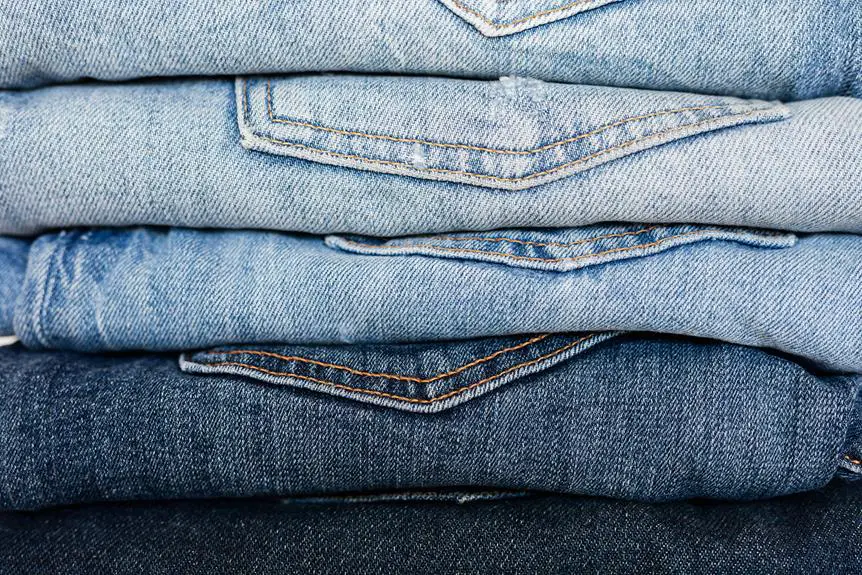To prevent color bleeding in your fabric storage, you need to take several key steps that can help maintain the integrity of your materials. It starts with understanding the causes of color bleeding and choosing the right storage materials. You'll want to wash your fabrics properly before storing them, and using color catcher sheets during laundry can be a game changer. But even with these precautions, there are additional considerations to ensure your fabrics stay vibrant and intact. Curious about what else you can do to protect your collection?
Table of Contents
Key Takeaways
- Wash fabrics separately using cold water and gentle detergents to prevent color bleeding and maintain vibrancy.
- Store fabrics in breathable, acid-free containers to avoid moisture buildup and dye transfer.
- Keep stored fabrics in a cool, dark place to protect against light exposure and fading.
- Regularly inspect fabrics for early signs of color bleeding and monitor humidity levels in the storage area.
Understand Color Bleeding Causes
Color bleeding often happens when fabrics come into contact with moisture or heat, causing dyes to transfer from one material to another. This issue frequently arises when wet fabrics are stored together, especially if one is dyed with unstable colors. If you've ever noticed a vibrant red fabric staining a lighter one, you've experienced color bleeding firsthand.
High humidity levels and temperature fluctuations can also contribute to this problem. When fabrics are exposed to heat, it can break down the dye molecules, making them more prone to leaking onto other items.
You might think that washing your fabrics beforehand will prevent bleeding, but if they're not washed properly, residual dye can still pose a risk.
Additionally, certain types of dyes are more susceptible to bleeding. For instance, reactive dyes often wash out more easily than others. Always check the care labels and be cautious with fabrics known for unstable colors.
Choose the Right Storage Materials
Selecting the right storage materials can significantly reduce the risk of color bleeding in your fabrics. First, consider using breathable fabric storage bags rather than plastic. While plastic can trap moisture, which leads to mold and color transfer, breathable materials allow air circulation and help maintain a stable environment.
Next, opt for acid-free tissue paper when storing delicate fabrics. Acidic papers can cause discoloration over time, so wrapping your items in acid-free tissue helps preserve their colors. You might also want to use cotton or linen storage containers instead of synthetic ones, as natural fibers are less likely to react with dyes.
When stacking fabrics, avoid heavy weights that can crush and compress them. Instead, use lightweight boxes or bins with dividers to keep your fabrics separate and prevent color transfer. If you need to use plastic containers, choose ones that are specifically designed for fabric storage and are UV-resistant to protect against sunlight.
Wash Fabrics Properly Before Storing
Before you store your fabrics, make sure to wash them properly to prevent color bleeding.
Use cold water rinses and choose gentle detergents to protect the fibers.
It's also important to separate dark and light fabrics to keep colors from transferring.
Use Cold Water Rinse
Washing fabrics in cold water helps prevent color bleeding and keeps your textiles looking vibrant for longer. When you prepare to store your fabrics, always opt for a cold water rinse. This method reduces the chance of dyes running, especially in new or brightly colored items.
Hot water can open up the fibers of your fabric, making it easier for colors to escape and transfer onto other materials. Using cold water, you'll maintain the integrity of the dye, ensuring your fabrics remain true to their original colors. Plus, a cold rinse is gentler on the fibers themselves, which means your fabrics will retain their strength and texture over time.
After washing, make sure to thoroughly rinse your fabrics. Any remnants of detergent or dirt can also contribute to color bleeding during storage. Cold water rinses effectively remove these residues without compromising the fabric.
Once you've rinsed your textiles in cold water, gently wring them out or use a low spin cycle to remove excess moisture. This extra step ensures that your fabrics are ready for storage without the risk of fading or bleeding.
Choose Gentle Detergents
Using gentle detergents is key to preserving the colors and quality of your fabrics during washing, especially when preparing them for storage. Harsh chemicals can strip the dyes from your fabrics, leading to fading and color bleeding. By opting for milder detergents, you can maintain the integrity of your textiles.
Here are some tips for choosing the right gentle detergent:
- Look for plant-based formulas: These are less likely to contain harsh chemicals that can harm your fabrics.
- Check for pH neutrality: A neutral pH helps prevent color fading and fabric damage.
When you wash your fabrics with gentle detergents, you not only preserve their appearance but also ensure they stay in good condition for years to come.
Always follow the care labels on your items and consider doing a patch test if you're unsure about how a detergent might affect a particular fabric.
Separate Dark and Light
To prevent color bleeding, always separate dark and light fabrics when you wash them. This simple step is crucial in maintaining the integrity of your garments. Dark fabrics, especially newly purchased ones, can release dye during washing. If you toss them in with lighter fabrics, you risk staining them permanently.
When sorting your laundry, create distinct piles: one for dark colors, another for light hues, and a third for whites. By washing them separately, you minimize the risk of dye transfer. It's wise to wash new items separately for the first few washes to gauge how much dye they may release.
Additionally, consider using cold water for washing, as it helps prevent colors from bleeding. Hot water can open the fibers of the fabric, making them more susceptible to losing dye.
Once your fabrics are washed and dried, ensure they're completely dry before storing them. Any residual moisture can cause colors to run together, especially in a confined space.
Use Color Catcher Sheets
Color catcher sheets can effectively prevent dye transfer between fabrics during the laundry process. When you toss these sheets into the wash, they absorb loose dyes that might otherwise bleed onto your favorite clothes. This simple addition can save you time, money, and the heartache of ruined fabrics.
Here are a few tips for using color catcher sheets:
- Choose the Right Sheets: Look for high-quality color catcher sheets that are specifically designed to absorb dyes.
- Use with Every Load: Make it a habit to add a sheet to every laundry load, especially when washing mixed colors.
Store Fabrics in a Cool, Dark Place
Storing fabrics in a cool, dark place helps prevent color fading and bleeding due to exposure to light and heat. Sunlight can degrade dyes in your fabrics, while heat can cause fibers to weaken, leading to unwanted bleeding. To protect your textiles, consider the following storage options:
| Storage Option | Benefits |
|---|---|
| Closet | Keeps fabrics away from light and heat. |
| Storage bins | Sealed bins reduce exposure to moisture and light. |
| Basements | Usually cooler and darker, ideal for long-term storage. |
| Under-bed storage | Utilizes space while maintaining darkness and coolness. |
| Fabric rolls | Prevents creasing and allows for easier access. |
Make sure the area you choose has good airflow to prevent mold and mildew. Avoid attics and garages where temperatures can fluctuate drastically. By taking these simple steps, you can significantly extend the life of your fabrics and keep their colors vibrant. Always remember: the better the storage conditions, the less chance you'll have of dealing with color bleeding in the future.
Regularly Check Stored Fabrics
To prevent color bleeding, you should regularly check your stored fabrics.
Inspect them for any signs of damage or discoloration, and keep an eye on humidity levels to avoid excess moisture.
Proper storage techniques will help maintain their quality and appearance over time.
Inspect Fabrics Frequently
Regularly inspecting stored fabrics helps catch any signs of color bleeding before it becomes a bigger problem. By taking the time to check your fabrics frequently, you can ensure they remain in optimal condition and prevent any irreversible damage.
Here's what to look for during your inspections:
- Fading Colors: Notice if any colors seem to have lost their vibrancy. This could be a sign that bleeding is starting to occur.
- Transfer Marks: Check for any odd stains or marks where one fabric might've touched another. This could indicate a risk of color transfer.
Setting a regular schedule for these inspections can help you stay on top of any potential issues. Depending on your storage situation, you might want to check weekly or biweekly.
Keeping your eye on your fabrics not only safeguards their beauty but also prolongs their life. So grab those fabrics and give them a good look-over—you'll be glad you did!
Monitor Humidity Levels
Monitoring humidity levels in your fabric storage area is crucial for preventing color bleeding and maintaining fabric quality. High humidity can cause dyes to run, especially in fabrics that aren't colorfast.
To keep your fabrics safe, invest in a hygrometer to track the moisture levels in your storage environment regularly. Ideally, humidity should stay between 30% and 50%.
If you find your humidity levels exceeding this range, consider using dehumidifiers or silica gel packets to absorb excess moisture. Conversely, if humidity levels are too low, you might want to introduce some humidity using a humidifier or placing a bowl of water nearby.
It's also a good idea to check for signs of mildew or mold, which thrive in damp conditions and can damage fabrics. Make it a habit to inspect your storage area and fabrics at least once a month.
This routine check can help you catch any potential issues early and take action before it leads to irreversible damage. By monitoring humidity levels diligently, you can effectively protect your fabrics and keep them looking vibrant for years to come.
Use Proper Storage
Checking your stored fabrics periodically helps catch any signs of color bleeding or damage before they become serious issues. By making this a regular habit, you can ensure your fabrics remain in great condition.
Here's what you should look for during your checks:
- Discoloration: Look for any fading or unusual spots that might indicate color bleeding.
- Moisture: Check for dampness or mildew, which can lead to fabric damage and color issues.
If you notice any problems, act quickly.
For discoloration, consider washing the affected fabric according to its care instructions.
If moisture is present, you might need to adjust your storage conditions to improve airflow and reduce humidity.
For pest issues, it's crucial to clean the storage area thoroughly and consider using protective measures like mothballs or cedar chips.
Frequently Asked Questions
Can I Use Plastic Bins for Fabric Storage?
Yes, you can use plastic bins for fabric storage. They're durable, moisture-resistant, and help keep your fabrics organized. Just ensure they're clean and dry to prevent any issues with mold or odors later on.
How Long Can I Store Fabrics Without Issues?
You can store fabrics for several months without issues, as long as you keep them in a cool, dry place. Just check periodically for any signs of damage or deterioration to ensure they're in good condition.
Do Mothballs Prevent Color Bleeding in Fabric Storage?
Mothballs don't prevent color bleeding in fabrics. They're designed to repel insects, not manage dye transfer. Instead, consider proper storage techniques like using breathable bags and separating colors to keep your fabrics vibrant and safe.
Are There Specific Fabrics More Prone to Color Bleeding?
Yes, some fabrics, like cotton, silk, and certain synthetics, are more prone to color bleeding. You should wash these items separately and use cold water to minimize the risk of unwanted color transfer during cleaning.
Can I Stack Different Colored Fabrics Together?
You can stack different colored fabrics together, but it's safer to separate them, especially if they're new. This way, you'll minimize the risk of color transfer and keep your fabrics looking vibrant longer.
- How Does Ring Spun Cotton Affect Garment Fit and Shape Retention? - August 13, 2024
- What Are the Challenges in Producing Ring Spun Cotton? - August 13, 2024
- Is Ring Spun Cotton Suitable for Plus-Size Clothing? - August 13, 2024






